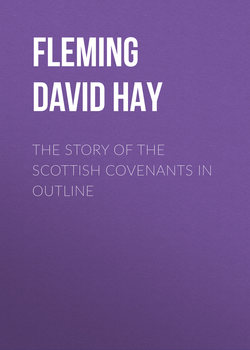The Story of the Scottish Covenants in Outline

Реклама. ООО «ЛитРес», ИНН: 7719571260.
Оглавление
Fleming David Hay. The Story of the Scottish Covenants in Outline
The Story of the SCOTTISH COVENANTS in Outline
Bands or Covenants
Personal Covenants
A Specimen
God our Portion
Supposed Band of 1556
Band of 1557
Bands of 1559
Rupture of French Alliance
French Excesses
Scots and English
Band of 1560
Treaty of Edinburgh
Band of 1562
The Queen’s Demission
Articles of 1567
St Bartholomew’s Massacre
The King’s Confession
The General Band
Band of 1589
Covenanting in 1590
Band of 1592-3
Covenanting in 1596
Erection of Episcopacy
Revolt of 1637
National Covenant
Glasgow Assembly
Assembly of 1639
Parliament of 1640
The English ask Help
Solemn League and Covenant
The Covenant enjoined
Montrose’s Army
Retaliation
The Engagement
Charles II. proclaimed King
King and Covenants
Dunbar and Scone
Resolutioners and Protesters
The Restoration
The King’s Honour
The Act Rescissory
Duplicity
Episcopacy Re-established
Argyll and Guthrie
Ministers Disqualified
Ministers Ejected
Church-Courts Discharged
Court of High Commission
Origin of Pentland Rising
Torture and Execution
The Indulgence
Conventicles
Public Worship
James Mitchell
The Ladies’ Covenant
The Cess
Sharp’s Death
Bothwell Bridge
Cameronians
Effect of Persecution
The Test
The Children’s Bond
Beatrix Umpherston
The Strategy of Claverhouse
The Success of Claverhouse
Apologetic Declaration
Priesthill and Wigtown
Conventicles
Dunnottar Prisoners
The Toleration
The Revolution
The Martyrs’ Monument
Heroic Sufferers
Отрывок из книги
Beginning at the left hand is Johnston of Warriston showing a letter to the Earl of Argyll, while Lord Eglinton is in the rear. Two ladies come next – the Marchioness of Hamilton, in widow’s weeds, seated, with Lady Kenmure standing beside her. The group around the tombstone includes Lord Rothes in the act of signing the document, Lord Louden, Lord Lothian, and the Earl of Sutherland; while Montrose is on the near side. Then there are Hope of Craighall, with the Rev. Samuel Rutherfurd, and in the foreground, standing on a tombstone, is the Rev. Alexander Henderson.
While they were opposed and oppressed by some of their former associates, they were, on the other hand, reinforced by the accession of outstanding men, like Richard Cameron and Thomas Forrester, who, in their earlier years, had complied with Prelacy; and by others, like James Renwick, Patrick Walker, and Sergeant Nisbet, who were born after the persecution had actually commenced. Men, and even women, were found ready and willing to endure all hardships, and to brave an ignominious death, rather than relinquish or compromise the principles which they held so dear, and to which, as they believed, the nation was bound by solemn covenants.
.....
The year 1559 was rendered notable in Scotland by the return of Knox, by the open rupture between the Congregation and the Queen Regent, and by the rapid progress of Protestantism. In the summer of that year the Reformers deemed it advisable to enter into at least three distinct covenants, their respective dates being the 31st of May, the 13th of July, and the 1st of August. None of the originals of these is known to have survived, but copies of all the three have been preserved. They had for their general object the advancement of the Reformation, but each had its own distinctive traits and special end. The first was entered into at Perth, the second at Edinburgh, and the third at Stirling. The second was adopted in St Andrews as the “letteris of junctioun to the Congregatioun,” and as such was taken by more than three hundred persons.
Not the least striking result of the Reformation was the complete bursting up of the ancient alliance between France and Scotland, and the drawing together of Scotland and England – that England which Scotland had so long and so recently regarded as its “auld enemy.” The importance of this result is frankly acknowledged by Teulet, one of the most competent, careful, and candid of French historical students. He puts the matter thus: “Scotland, which was for so many ages the devoted ally of France, the rein, as our ancient kings said, with which they restrained the encroachments of England, was unwilling to abdicate its nationality and become a French province. Moreover, the unbridled excesses of the French troops in Scotland, no less than the shameless rapacity of the French agents, at last aroused a general spirit of resistance, and England soon found in the rupture of the ancient alliance between France and Scotland an ample indemnification for the loss of Calais.”
.....